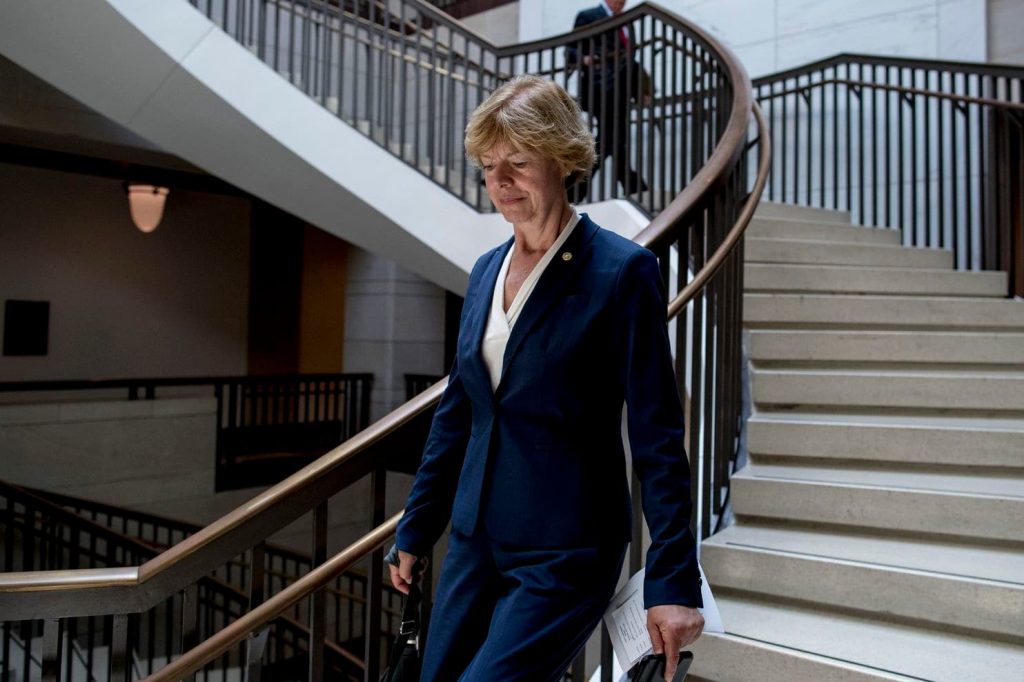By David J. Lynch | July 30, 2019 | Washington Post
Federal Reserve Chair Jerome H. Powell has spent several months fending off President Trump’s demands to lower the value of the dollar to help American manufacturers sell their goods abroad. Under a bipartisan Senate bill due Wednesday, the central bank chief no longer would have any choice.
Sens. Tammy Baldwin (D-Wis.) and Josh Hawley (R-Mo.) are introducing legislation that would require the Fed to balance the nation’s current account, the broadest measure of the trade balance, within five years. Under the bill, the task would become a third official mandate for the Fed, along with maintaining stable prices and promoting full employment.
The legislation would empower the Fed to impose a “market access charge” on all foreign purchases of U.S. stocks, bonds, property and other assets. Supporters say the modest fee would discourage speculative short-term investments, reducing demand for dollars and causing the greenback to settle at a lower value, while not discouraging purchases of long-term assets such as factories.
Foreign investors purchased more than $21 trillion worth of U.S. stocks and bonds last year, according to Fed data.
Those backing the cross-border tax say the dollar’s value has been persistently elevated for decades, making American goods more expensive on world markets and encouraging U.S. consumers to buy imports. The resulting trade deficits have erased millions of U.S. factory jobs, they say.
“Exchange rates are the tectonic plates upon which the rest of trade and economic policy are built. You’ve got to fix that first,” said Michael Stumo, chief executive of the Coalition for a Prosperous America, a nonprofit organization that favors restrictive trade policies.
The Baldwin-Hawley proposal, which will probably face stiff opposition from the financial industry, will be introduced as the Fed’s Board of Governors wraps up a two-day meeting widely expected to reduce the benchmark U.S. interest rate by a quarter of a percent, the first cut since 2008. Coming after an 18-month blitz of Trump tariffs, the initiative shows that the trade debate is devoting greater attention to global currency issues.
On Tuesday, the president said he was “very disappointed in the Fed,” which he blames for keeping interest rates higher than key U.S. trading partners such as the euro-using countries in Europe. Higher rates attract more capital and push the dollar up, according to economists.
“The E.U. and China will further lower interest rates and pump money into their systems, making it much easier for their manufacturers to sell product. In the meantime, and with very low inflation, our Fed does nothing — and probably will do very little by comparison. Too bad!” Trump tweeted one day earlier.
There is wide agreement that the dollar is overvalued, though economists differ on both the extent and the significance. Rob Scott, an economist with the Economic Policy Institute, a liberal group, said the dollar needs to sink by 25 percent to 30 percent. The International Monetary Fund this month said the dollar was 6 percent to 12 percent too high.
Global currency values reflect a long-standing imbalance in the global economy. Countries such as Germany and China keep wages relatively low, discouraging consumption. They export their national savings to the United States, which consumes more than it produces and runs a trade deficit.
American consumers, in short, absorb the excess production that keeps Chinese and German factory workers employed, according to the bill’s supporters.
Still, today’s account deficit is just 2.5 percent of GDP, down from a high of more than 6 percent in 2005.
Hawley accused China and other countries he said manipulated their currency with waging “financial war” on the United States.
“Foreign investors have driven up the American dollar, helping Wall Street profit but holding back stronger economic growth,” Baldwin said in a statement. “We need reforms that create a competitive American dollar and an even playing field for manufacturers, farmers and workers.”
Over the past 18 months, the president has attacked what he calls unfair trade practices by imposing tariffs on solar panels, washing machines, industrial metals and about half of all U.S. merchandise trade with China.
He has secured new trade deals with South Korea and Canada and Mexico, but the trade deficit last year hit a record $891 billion.
“He’s fixing a 21st-century problem with a 19th-century approach,” said Michael Pettis, a finance professor at Peking University’s Guanghua School of Management who favors the market access charge.
During the 2016 campaign, Trump vowed to target China for allegedly reducing the value of the yuan to gain a trade advantage. But the Treasury Department has shied from officially labeling Beijing a currency manipulator.
Likewise, despite his attacks on the Fed, the president has for now rejected proposals from Peter Navarro, a White House aide, to drive down the dollar’s value. A Commerce Department plan to impose duties on trading partners that effectively subsidize exports by depressing the value of their currency also may be stillborn. It has been opposed by the U.S. Chamber of Commerce and is expected to be blocked by the Treasury.
Wall Street also is certain to oppose the proposed tax on capital flows. The measure could make it harder to buy and sell securities, increasing financial market volatility, said Clay Lowery, executive vice president of policy and research at the Institute of International Finance, an industry group.
“Instead of welcoming foreign investors, we’d say we’re going to tax you for being foreign,” said Lowery, a former treasury official. “That’s a recipe for the uncompetitiveness of U.S. markets and the economy.”
Share your comments below:













